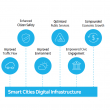In this video, the Axa Group describes some of the many ways that Smart Cities will make life better for urban dwellers.
Did you know that by 2050, 70% of the world’s population will be city dwellers? Smart cities use new technologies and data management to achieve sustainable development and adapt to this rise in urbanization. At AXA, our ambition is to use our experience and know-how to help governments, businesses and citizens to creating better cities for tomorrow!
The development of smart cities has impacted multiple industries, particularly mobility, healthcare, physical infrastructure, energy management, security and urban governance. There is no ideal smart city model to follow: instead, there are a multitude of possibilities to choose from, based on each city’s individual features and needs. At AXA, we have designed four approaches to understand the different ways a city can develop and the role insurance can play to better protect the cities of tomorrow.
The Sectorial Approach
Today, smart city developments are very sector-specific. Smart solutions are implemented pragmatically and on a case-by-case basis, most often with a focus on mobility, security or resource management. Insuring the smart pillars of tomorrow’s cities will be fundamental. This can mean insuring smart mobility, smart water management, etc. For example, in Bristol, AXA is involved in several projects to analyze how risk assessment and risk coverage should evolve to address smart mobility.
The Risk Prevention Approach
When smart cities or smart districts are built from scratch, or when city urban planning is reassessed, insurance knowledge will be key to the city’s risk prevention strategy. For instance, AXA has flood and other specific risks’ maps that can be of valuable use. Providing risk prevention advice to better shape the future of tomorrow’s cities will also be essential to facing the challenge of climate change.
Many cities are now equipped with data platforms, which can help innovators provide new solutions for programming the mobility of its citizens or reducing exposure to pollution, for example. By plugging into these platforms, insurers can offer new types of parametric covers.
The Metabolism Approach
The concept of a city’s metabolism encompasses the idea that cities grow like natural organisms and can therefore integrate natural features to respond to their needs. City stakeholders aim to provide tools to help a city follow its “natural” tendencies. In this bottom-up approach, the smart city develops along with the citizens of the gig economy. AXA is studying ways to provide these atypical workers of tomorrow with the right level of protection they need.



Leave a Comment